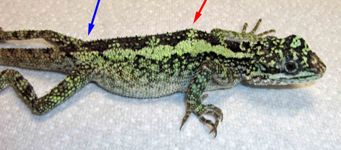Basic Care: Neon Tree Dragon
 Neon tree dragon is a common name used in the pet trade for a variety of small agamid lizards from southeast Asia. Agamid lizards are an Old World family of lizards that include bearded dragons and uromastyx lizards.
Neon tree dragon is a common name used in the pet trade for a variety of small agamid lizards from southeast Asia. Agamid lizards are an Old World family of lizards that include bearded dragons and uromastyx lizards.
In 2010, neon tree dragon refers to Japalura splendida which is pictured above. Its adult size is 10 to 12 inches total length. In the past, this was sometimes used for Calotes versicolor. All of the lizards sold as "neon tree dragons" are very territorial and easily stress in crowded conditions. They do best housed with no more than 2 dragons per 20 gallon tank with at least one hiding spot (such as a hollow piece of cork) and one bright basking spot per lizard. Lots of plastic plants or live plants are needed to break up the sight lines so the lizards can hide from each other easily.
In addition to a basking spot that hits 90-95°F during the day, neon tree dragons need strong UVB light for at least 10 hrs a day or else they readily develop nutritional secondary hyperparathyroidism (a form of metabolic bone disease). They also need high humidity and frequent spraying as they only drink from droplets. If they do not get enough humidity, they will retain shed skin (as may be seen on the tip of the nose of the dragon at the top of this page). However, they also need plenty of fresh air or else they develop skin infections.
They do best with crickets no longer than the space between the dragon's eyes. Some will eat waxworms. It is important to dust the insects at every meal with a calcium supplement containing D3 such as Zoomed's Calcium with D3 and a once a week dusting with a multivitamin containing pure vitamin A such as Zoomed's Reptivite.

This neon tree dragon has a broken back as a result of a metabolic bone disease (red arrow). There is also a change in color (blue arrow) showing where there is unshed skin.
Little is known about the long-term care and breeding of Japalura splendida but following the guidelines for green anoles (Anolis carolinensis) is a suggested starting point.
Unfortunately the neon tree dragons are almost always wild-caught imports and suffer from a variety of intestinal parasites and other infectious diseases. It is extremely important to have your new neon tree dragon checked for parasites by submitting a fresh fecal sample to a veterinarian within the first few days of bringing it home.



